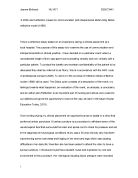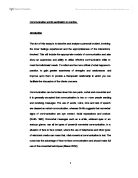As it turned out on my first day I was still a bit nervous but I knew I had a friendly
face to look out for during the first few hours. Even after the nerves had settled a bit
my self-awareness of the way I was communicating became more heightened in this
new environment. It is important that we have some understanding our own reactions
to what other people say and do and indeed, what we ourselves say and do, and why.
This is the key to effective interpersonal skills, particularly those underpinning caring
relationships (Kagan, 1995).
During the initial “Hello’s” with other staff and ultimately the patients I knew that any
form of communication whether verbal or non-verbal would create those all-important
lasting first impressions. Carl Rogers (1967) wrote about the qualities of care workers
and their genuineness and how quickly their words and actions become apparent to
their patients. I knew I had to show that I was a genuine and caring person- my
preceptor encouraged me with this.
About four weeks into my placement one end of the ward became occupied by
Three gentlemen who all liked to have a joke and the conversation was quite animated
at times. One particular man, Mr Ashcroft became friendly with me primarily, I
suspect, as we were both born in the same town on the other side of the country. Mr
Ashcroft, a 58-year-old man, was making steady psychological and physical recovery
from a stroke. He was able to communicate although he had difficulties connected
with answering long or complex questions. He was also noted to have some episodic
spells of emotional upset. The emotional problems were related to his stroke but were
also seen as a more general reaction to his shock at his sudden illness and subsequent admission to hospital.
One evening as the sun set over Fife I remarked how red the sky was and recalled an
old saying “Red sky at night shepherd delight”. A discussion about whether it was a
shepherds warning or a sailors warning- or perhaps it was meant to be in the morning
was initiated. They seemed to be enjoying the topic of conversation.
I remarked that I thought it came from some where in the Bible. I knew one of the
four could corroborate that for me, as I knew he was a regular churchgoer. Just as I
was contemplating that Hugh said, in very clear language, that he didn’t believe in the
Bible and it was all a lot of rubbish. This statement exactly coincided with the other
man proffering that it was Mathew Chapter 12 that talks about watching the sky for
prophecy.
Silence.
This is not a communication report about religion. These too gentlemen had got on so
well and now they had silenced each other. The man who I knew went to church had
not been particularly offended. Hugh however, had realised what he had said and
looked as if he now regretted offending the other patient in such a manner. He became
quite agitated. The focus of his agitation was himself.
I, on the other hand, felt a bit responsible for the whole situation as I had first
broached the subject.
The other patient was quite calm and remained quiet as Hugh tried to communicate
his apology. Hugh’s condition did not improve as he made himself more upset in
trying to apologise.
Again, as I felt a bit to blame I tried to mediate. Remembering a recent lecture on the
importance of body language in communication I recalled a technique proposed by
Gerard Egan that I had come across in doing some lateral reading around this subject.
I quickly rehearsed the mantra- S.O.L.E.R.
S- Sit or stand squarely, O- Open posture, L- Lean in the general direction of the
patient, E- eye contact to be maintain in a good unthreatening manner and R- relax.
Egan (1986). I had that in the back of my mind as I approached Hugh in a hopefully
unthreatening manner with a smile on my face. I knew how important the first few
seconds would be here and I was aware of the importance of facial expressions and
how they play a large part in our communication in times of stress.
Only after I had crouched down in front of Hugh did I begin to use words. Whilst
approaching Hugh I had decided not to use open questions and to use closed questions
in a clear and friendly manner using restricted amounts of language.
I simply asked Hugh if the other patient looked upset. He looked over said no and
reinforced this with a shake of his head.
I would like to claim to be an excellent diplomat and that he settled right a way. But
He did settle fairly soon and was talking in good spirit shortly afterwards.
My paradigm of a stressful piece of communication in the ward is not particularly
earth shattering or exemplary. However, I chose to focus on this short event as it let
me explore not only how the patient felt but also and probably more importantly how
I felt.
To explore an event such as this one can employ the help of Reflective Models and
Process recording. To explore the reactions of others and to evaluate the
appropriateness of my actions I used the ‘reflection after-the-action’ perspective. The
cognitive post mortem as is otherwise called, as described in Marks-Maran and
Rose’s ‘Reconstructing Nursing- Beyond Art and Science’ helped me to look back at
this incident. To reassess my actions. Explore my feelings and to be an impartial
though hopefully benevolent critic or judge of myself and of the whole interaction
itself.
Merely reading about the various ideas on reflective practice and reflection allowed
me to precipitate a concrete framework around which I could explore the evidence for
my process-recording sheet. Put more clearly, rather than having a disembodied and
inarticulate series of unsubstantiated hunches, thoughts and ideas I had solid
abstraction of my study of the event. This I found particularly useful when trying to
relate the event to others. I hope this is echoed in the merit of the clarity of it’s re-
telling in the body of this missive.
Moving on from merely reading, the act of completing the Process Recording Sheet
put substance to my feelings. The more you look at any incident the more you realise
that from your own communication perspective- you only have one view- not an
omnipotent view- a frail human singular impression. One can only begin to imagine
exactly how other individuals perceive similar events, let alone how they feel about it.
The concept of the activity of nursing involving the “unseen side of a cube” as
developed by Marks-Maran (1997. pg 147) appealed to me. Where all the different
views on things overlap perhaps there will be a reconciliation of perspectives.
In conclusion, within my paradigm there was no way I could really understand exactly
how Mr Ashcroft felt. All I could do was try my best and let him know I was there
and that I cared. In Patricia Benners ‘The Primacy of Caring’ she explores this
universality of Caring and how important it is to communicate that you care to the
people around you, not just patients. This is important, however it would be folly not
to recognise the “importance of communication and interpersonal skills in providing
good quality patient care” (Clark,D.J. 1998, pg 143). It has been an old truism that it
is not what you say but how you say it.
“If we take seriously the idea that caring is the future of all healthcare…it is not that
we care which is moral, but how we care” –Marks-Maran (1997, pg 87)
I feel that is why communication is so important to nurses. Of course nurses need to
be academics at times and have excellent fine motor skills but all this would be lost if
they communicate and express themselves inadequately to patients- and to each other.
References
BENNER, P., et al. (1989). The Primacy of Caring- Stress and Coping in Health and
Illness. Addison-Wesley Publishing. Wokingham, England.
CLARKE, D.J. (1998). Process Recording of what value is examining nursing
interaction through assignment work. Nurse Education Today, 1998 Feb: 18 (2).
EGAN, (1986) The Skilled Helper. 3rd edition. Brooks/Cole Publishing. Pacific Grove, California.
KAGAN, C., EVANS, J. (1995) Professional Interpersonal Skills for Nurses. Chapman and Hall. London
MARKS-MARAN, D., Et al. (1997) Reconstructing Nursing; Beyond Art and Science. Bailliere Tindall. London.
POTTER & PERRY. (1995) Foundations in Nursing Theory and Practice. 3rd Edition.
Mosby. St.Louis, Missouri.
ROGERS, C., (1967) On Becoming a person: A Therapist’s view of psychotherapy. Constable. London
SHERMAN, K., (1994) Communication and Image in Nursing. Delmar Inc. Albany, N.Y.
UKCC., (1992) Code of Professional Conduct. 3rd Edition. London.
CONTENTS PAGE
- Communication Report.
- Appendix One – Process Recording Sheet.
9 References.







